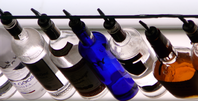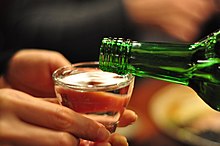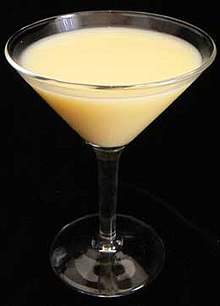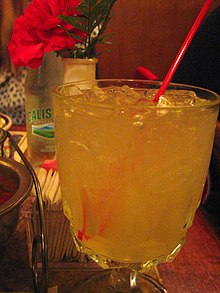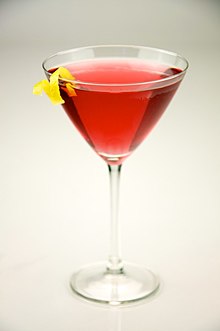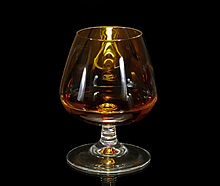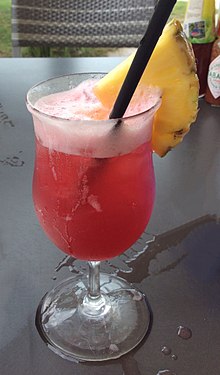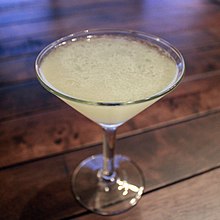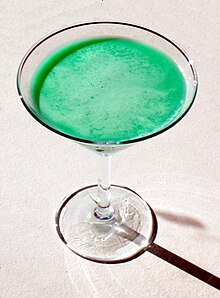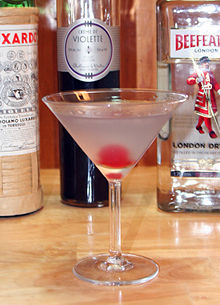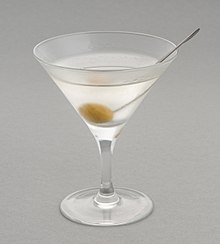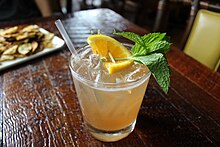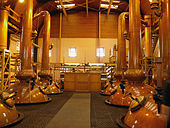Portal:Liquor
|
Distilled beverages | Baijiu | Brandies | Fruit brandies | Distilled ciders | Drink distillers | Fermented teas | Fortified wine | Gins | Horilkas | Liqueurs | Neutral grain spirits | Pisco | Rice drinks | Rums | Tequila | Vodkas | Whisky/Whiskey Introduction 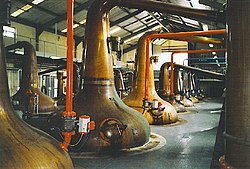 Liquor (/ˈlɪkər/ LIK-ər) is an alcoholic drink produced by the distillation of grains, fruits, vegetables, or sugar that have already gone through alcoholic fermentation. Other terms for liquor include: spirit, distilled beverage, booze, spirituous liquor or hard liquor. The distillation process concentrates the liquid to increase its alcohol by volume. As liquors contain significantly more alcohol (ethanol) than other alcoholic drinks, they are considered "harder." In North America, the term hard liquor is sometimes used to distinguish distilled alcoholic drinks from non-distilled ones, whereas the term spirits is more commonly used in the UK. Some examples of liquors include vodka, rum, gin, and tequila. Liquors are often aged in barrels, such as for the production of brandy and whiskey, or are infused with flavorings to form flavored liquors, such as absinthe. While the word liquor ordinarily refers to distilled alcoholic spirits rather than beverages produced by fermentation alone, it can sometimes be used more broadly to refer to any alcoholic beverage (or even non-alcoholic products of distillation or various other liquids). (Full article...) Selected article -Soju (/ˈsoʊdʒuː/; Korean: 소주; Hanja: 燒酒) is a clear and colorless Korean distilled alcoholic beverage, traditionally made from rice, but later from other grains and has a flavor similar to vodka.It is usually consumed neat. Its alcohol content varies from about 12.5% to 53% alcohol by volume (ABV), although since 2007 low alcohol soju below 20% has become more popular. Traditionally, most brands of soju are produced in the Andong region, but also in other regions and countries. While soju was traditionally made from the rice, South Korean ethanol producers replace rice with other starch, such as cassava due to significantly lower capital costs. Soju often appears similar to several other East Asian liquors while differing in alcohol contents. (Full article...)Selected biography - General articles -Did you know -
This is a Good article, an article that meets a core set of high editorial standards.
 Christian views on alcohol are varied. Throughout the first 1,800 years of Church history, Christians generally consumed alcoholic beverages as a common part of everyday life and used "the fruit of the vine" in their central rite—the Eucharist or Lord's Supper. They held that both the Bible and Christian tradition taught that alcohol is a gift from God that makes life more joyous, but that over-indulgence leading to drunkenness is sinful. However, the alcoholic content of ancient alcoholic beverages was significantly lower than that of modern alcoholic beverages. The low alcoholic content was due to the limitations of fermentation and the nonexistence of distillation methods in the ancient world. Rabbinic teachers wrote acceptance criteria on consumability of ancient alcoholic beverages after significant dilution with water, and prohibited undiluted wine. In the mid-19th century, some Protestant Christians moved from a position of allowing moderate use of alcohol (sometimes called "'moderationism") to either deciding that not imbibing was wisest in the present circumstances ("abstentionism") or prohibiting all ordinary consumption of alcohol because it was believed to be a sin ("prohibitionism"). Many Protestant churches, particularly Methodists, advocated abstentionism or prohibitionism and were early leaders in the temperance movement of the 19th and 20th centuries. Today, all three positions exist in Christianity, but the original position of alcohol consumption being permissible remains the most common and dominant view among Christians worldwide, in addition to the adherence by the largest bodies of Christian denominations, such as Anglicanism, Lutheranism, Roman Catholicism, and Eastern Orthodoxy. (Full article...)Selected image -Related portalsTopicsRelated topicsGeneral images -The following are images from various liquor-related articles on Wikipedia.
GarnishesVarious cocktail garnishes
List articles
Producers CategoriesStub articles The following stub articles can be expanded. Related WikiProjects
Associated WikimediaDistilled beverages
The following Wikimedia Foundation sister projects provide more on this subject:
Distilleries
The following Wikimedia Foundation sister projects provide more on this subject:
Web resources
More portals |

